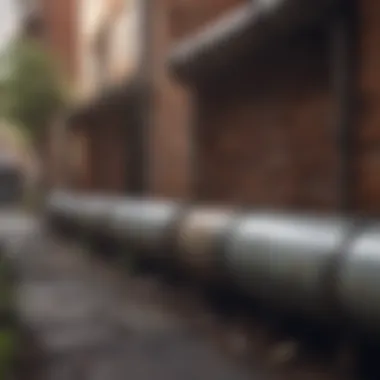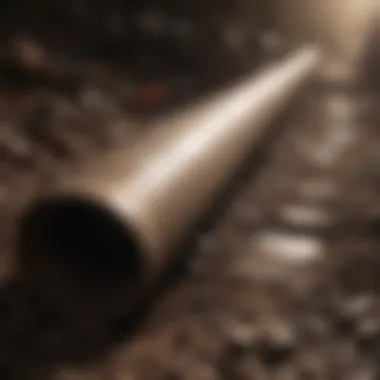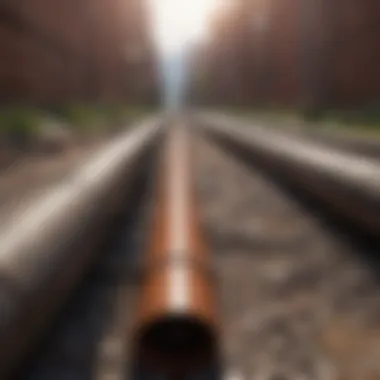Understanding Underground Pipe Insurance: A Vital Guide


Intro
In the modern landscape of home ownership, the integrity of utility infrastructure is often overlooked. Homeowners frequently underestimate the significance of underground pipes, leading to potential hazards and financial liabilities. This is where underground pipe insurance comes into play. It serves as a safeguard against various risks associated with damaged pipes that lie beneath one's property. As urban development continues to advance and as aging systems degrade, understanding the nuances of this insurance becomes essential.
Overview of Financial Product
Definition
Underground pipe insurance is a specialized form of coverage that protects homeowners from costly repairs due to damage to utility pipes hidden underground. These pipes can include water supply lines, sewage systems, and gas pipelines. Damage can arise from various sources, including ground shifts, natural disasters, or even mundane wear and tear.
Key Features
- Coverage options: Policies often differ in breadth, including options for standard repairs and comprehensive coverage for multiple utilities.
- Eligibility criteria: Different insurers may have varying rules regarding property age and location.
- Limited exclusions: Many policies will outline what is not covered, primarily focusing on pre-existing conditions or deliberate damage.
Purpose and Benefits
The primary purpose of underground pipe insurance is to mitigate financial strains arising from unexpected damage. The benefits include:
- Financial protection: It evades hefty repair bills born from sudden pipe failures.
- Peace of mind: Homeowners can rest easy, knowing that they have coverage.
- Increased property value: Well-maintained utilities can enhance property appeal.
Types and Categories
Insurance Types
There are generally two broad categories of underground pipe insurance:
- Basic coverage: Typically covers common issues like water leaks or pipe bursts.
- Comprehensive coverage: This may also address damages from environmental factors or issues stemming from poor workmanship in installations.
Pros and Cons
Pros
- Protection against unforeseen costs
- Assurance during extreme weather events
Cons
- Cost of premiums can add up over time
- Some find coverage terms and conditions complex
Situational Uses
This coverage is particularly valuable for:
- Older properties: Where infrastructure may already be compromised.
- Areas prone to natural disasters: Such as regions with earthquakes or severe storms.
Application Process
Steps to Apply
- Research insurers: Investigate different providers in your area.
- Obtain quotes: Contact insurance agencies for personalized quotes based on your property.
- Select the policy: Assess all options and choose what suits your needs.
Eligibility Requirements
Eligibility often hinges on factors such as:
- Location of the property
- Age of the property
- Maintenance history of existing utilities
Documentation Needed
You may need to provide:
- Proof of property ownership
- Previous insurance documentation
- Maintenance records for utility systems
Common Mistakes to Avoid
- Failing to read policy details thoroughly
- Not comparing multiple quotes
- Ignoring state regulations concerning underground utilities
Tips for Success
- Engage in comprehensive research
- Ask questions during the application process
- Consult with industry professionals to ensure clarity
Costs and Fees


Types of Fees Associated
The fees for underground pipe insurance can vary. Generally, these may include:
- Monthly premiums: Ongoing costs based on coverage chosen.
- Deductibles: Out-of-pocket costs before insurance kicks in for claims.
Comparisons of Costs Across Options
Comparing policies is crucial. Different insurers may charge varying premiums for similar coverages based on risk assessments of your location. Look for similar terms, coverage limits, and exclusions when evaluating options.
Preface to Underground Pipe Insurance
Underground pipe insurance is a topic of growing concern for homeowners and renters alike. As properties increasingly rely on buried utility systems, understanding this form of insurance becomes necessary. Many people may not realize the potential risks associated with underground pipes, such as aging infrastructure and environmental hazards. This article aims to delve into the definition, importance, and relevance of underground pipe insurance in today’s world.
Definition and Importance
Underground pipe insurance is designed to protect property owners from financial losses resulting from damage to utility pipes buried beneath their premises. These pipes can include water supply lines, sewer systems, and gas lines. It covers various accidents, including burst pipes, leaks, and the resultant structural damages. The importance of this insurance cannot be overstated. Without it, homeowners may face significant repair costs and potential legal liabilities.
This type of insurance also addresses the hidden nature of these pipes. Homeowners often fail to account for the age and condition of underground systems until damage occurs. By investing in this insurance, property owners can secure peace of mind knowing they are safeguarded against unpredictable events.
Relevance in Today's Infrastructure Landscape
Today, many areas face challenges related to aging infrastructure. Underground pipes across the country are deteriorating due to factors such as weather conditions, soil compaction, and general wear over time. As a result, more homeowners are experiencing issues related to pipe damage and leakage. This makes underground pipe insurance particularly relevant now, more than ever.
Moreover, as urbanization increases, the demand for utility services rises. Overburdened systems can lead to failures and thus increase the likelihood of damage in residential properties. Understanding underground pipe insurance and its benefits is crucial for individuals living in urban or suburban spaces.
Investing in underground pipe insurance is not just a precaution; it is a necessary step for responsible homeownership in today's landscape.
Understanding the Basics of Underground Pipes
Understanding underground pipes is essential in the context of property management and insurance. These pipes form the unseen backbone of residential and commercial infrastructure. Their roles extend from supplying water to managing sewage and providing gas for heating and cooking. Awareness of the types of pipes, common issues, and their impact on property integrity is vital for homeowners and property managers. Recognizing these factors aids in making informed decisions about underground pipe insurance.
Types of Underground Pipes
Water Supply Pipes
Water supply pipes deliver potable water to homes and businesses. They are crucial in ensuring that clean water is accessible for various needs. The most common materials for these pipes include copper, PVC, and PEX. Each material has unique characteristics: copper is known for durability, while PVC is more affordable and flexible. The downside of water supply pipes is that they can be susceptible to freezing, leading to cracks.
Sewer Lines
Sewer lines are responsible for carrying wastewater away from properties. These pipes are usually made from materials like clay, cast iron, or PVC. A significant characteristic of sewer lines is their ability to handle diverse types of waste. However, their effectiveness can be compromised due to age and wear, necessitating regular maintenance and eventual replacement. Failure to manage sewer lines can lead to severe property damage and health hazards.
Gas Lines
Gas lines transport natural gas to appliances for heating and cooking. They are typically made of steel or polyethylene. A key aspect of gas lines is their strict regulation; they must meet safety standards to prevent leaks. Gas line failures can result in hazardous situations such as explosions or carbon monoxide poisoning. Regular inspection is essential to ensure their integrity.
Common Issues with Underground Pipes
Corrosion
Corrosion in underground pipes occurs due to chemical reactions with soil or water. It is a major concern for metal pipes and can lead to leaks and failures. A significant feature of corrosion is its gradual nature, which means it can go unnoticed until damage is extensive. Preventive measures like using corrosion-resistant materials can be beneficial. Homeowners should consider regular inspections to catch corrosion early.
Blockages
Blockages in underground pipes can cause backflow and other plumbing issues. They often result from debris accumulation, tree roots, or grease buildup. Identifying blockages early is important. Ignoring them can lead to costly repairs and disruptions. Regular maintenance, such as snaking or hydro-jetting, can prevent blockages and prolong the life of pipes.
Root Intrusion
Root intrusion occurs when tree roots penetrate underground pipes seeking moisture. This issue is common with older sewer lines and can result in significant damage. The growth of roots can lead to severe blockages, necessitating costly repairs. Homeowners need to assess tree placement and root barriers to mitigate such risks. Regular checks can help identify early signs of intrusion before they become problematic.
The Necessity of Underground Pipe Insurance
Underground pipe insurance is essential for homeowners and property investors alike. It addresses risks and costs associated with buried utility lines. Given that these pipes lie out of sight, many neglect their potential issues until it's too late. Without proper insurance, damage can lead to significant financial burdens. Moreover, understanding this coverage helps in making informed choices that safeguard one's investment.
Financial Implications of Pipe Damage
Damages to underground pipes can have far-reaching financial implications. Repair costs for damaged pipes vary widely based on the extent of the damage. A small leakage might seem minor initially, but ignoring it can cause extensive water damage or lead to property devaluation. Here are key financial aspects to consider:
- Repair Costs: Fixing underground pipes can be expensive. Between excavation, material, and labor costs, expenses can escalate quickly.
- Potential Property Damage: If a pipe bursts, the resulting damage can affect foundations, flooring, and other structures. This could lead to costly renovations.
- Loss of Utility Services: A damaged pipe can cut off essential services, causing temporary relocations and inconvenience. These disruptions often come with additional costs.
- Increased Premiums: Without insurance, any damages incurred can lead to increased claims later. This could subsequently raise future insurance premiums.
By investing in underground pipe insurance, homeowners protect themselves from these unpredictable financial burdens, ensuring peace of mind in times of crisis.


Legal Obligations and Responsibilities
Understanding the legal obligations concerning underground pipes is crucial. Homeowners often bear the liability for issues that arise within their property boundaries, including pipe damages. This can lead to legal complications:
- Negligence Claims: If a pipe issue leads to property damage outside one's property, a homeowner could face negligence claims from neighbors or local authorities.
- Regulatory Compliance: Various municipalities have regulations in place regarding underground utilities. Property owners must be aware of these laws to avoid potential fines.
- Property Disclosure: When selling property, it is legally required to disclose past damages or issues with underground pipes. Failing to do so could lead to legal repercussions.
This is why having the right underground pipe insurance is not only a protective measure but also a necessary compliance strategy. By ensuring coverage, homeowners can confidently navigate their responsibilities without the fear of unexpected legal challenges.
Types of Coverage in Underground Pipe Insurance
Understanding the types of coverage in underground pipe insurance is essential for homeowners. This section highlights what these covers can do. They help safeguard against damages that can occur unexpectedly. Different plans offer varying degrees of protection, affecting financial liability. Knowing these types can improve your decision-making regarding your policy.
Basic Coverage
Basic coverage typically includes essential protection for damage caused by a variety of issues. This usually covers damages from sudden incidents, such as breaks or leaks in the pipes. Most basic policies may not cover everything, but they provide a foundational layer of security.
Key aspects of basic coverage include:
- Leaks: Coverage for damages caused by pipe leaks, ensuring any immediate damage to property is handled.
- Breaks: Financial help for costs arising from a complete pipe break.
- Limited Coverage: Basic policies tend to have limits which could affect total claims.
Understanding these factors can guide homeowners on whether to add more protection.
Enhanced Coverage Options
Enhanced coverage options offer broader protection than basic coverage. They can include supplementary features for added peace of mind. For example, enhancements might cover environmental damage or consequences from pipe failures that occur over time.
Consider these enhancements:
- Root Intrusion: Coverage for damages caused by tree roots affecting pipes.
- Environmental Damage: Issues caused by leaks affecting the soil or groundwater.
- Maintenance Costs: Some policies may also cover repair costs associated with regular maintenance.
Acquiring enhanced coverage could be a wise choice for homeowners, especially in areas with older infrastructure.
Exclusions in Policies
While understanding coverage is vital, knowing what is excluded is equally important. Exclusions often can leave homeowners financially responsible for significant damages. Many policies exclude coverage for issues resultant from negligence or natural disasters, like floods.
Common exclusions include:
- Negligence: Damage resulting from lack of maintenance is generally not covered.
- Pre-existing Conditions: Issues present before the policy activation are often excluded.
- Certain Natural Disasters: Some policies exclude floods, earthquakes, or other acts of nature.
Be aware of what is not included in your policy, as this can impact your financial planning and readiness for potential risks.
Determining the Cost of Underground Pipe Insurance
Understanding the cost of underground pipe insurance is crucial for homeowners. It highlights financial responsibilities and potential savings. The aim is to provide clarity on how insurance providers calculate premiums. It also sheds light on the connection between coverage and costs, which is vital for making informed decisions.
Factors Influencing Premiums
Various elements affect the premiums for underground pipe insurance. Recognizing these factors helps homeowners anticipate costs better. The most significant factors include:
- Location: Geographic risks, like flooding or earthquake probability, can increase premiums significantly.
- Age of Pipes: Older pipes often face more issues, leading to higher insurance costs. Newer installations may qualify for lower rates due to reduced risk.
- Type of Pipe: The material and function of the pipe influence coverage needs. For example, a gas line may come with higher premiums compared to a standard water pipe because of the associated risks.
- Previous Claims: A history of claims may signal a higher risk to providers, resulting in increased premiums for the homeowner.
- Coverage Amount: The choice of coverage limit directly correlates to the premium cost, as higher coverage values lead to higher costs.
Recognizing how these factors play into the overall cost allows individuals to assess their specific situation better. It also helps in negotiating better terms with insurance providers.
Average Costs of Policies
The average costs of underground pipe insurance vary widely based on multiple factors. On average, homeowners might expect to pay between $300 to $1,500 annually. Here are some details to consider:
- Basic Coverage: Typically falls at the lower end of the spectrum, around $300 to $600 per year, depending on geographic risk.
- Enhanced Coverage: This can range from $600 to $1,500. Enhanced plans may cover more extensive damages and offer additional benefits, like faster claim processing.
- Consider Variations: Weather patterns, local regulations, and specific pipe conditions can result in fluctuations in pricing.
Homeowners should understand these average costs help in budgeting for insurance. Curret trends indicate increased awareness of underground pipe insurance. Many homeowners now see it as an essential investment, given the aging infrastructure and unpredictability of environment-related damages.
Investing in underground pipe insurance can protect against unforeseen costs that arise due to pipe damages.
By evaluating these details, families and young professionals can make informed choices. This insight not only prepares for potential expenses but also supports better understanding when speaking with insurance representatives.
How to Choose the Right Insurance Provider
Choosing an insurance provider for underground pipe insurance is crucial. It is not only about comparing prices but also understanding the specific needs of your property. The right provider can offer better coverage options, making sure that you are protected in case of any issues. This decision can have long-term implications on your financial wellbeing and peace of mind.
Key Considerations


When selecting an insurance provider, several factors play a significant role:
- Coverage Options: Ensure the provider offers policies that meet your specific needs, including various types of underground pipes.
- Reputation: Research the provider’s reputation in the industry. Look for reviews and testimonials from current or past customers.
- Financial Stability: Select an insurer with a strong financial background, as this indicates their capacity to pay claims when needed.
- Policy Flexibility: A good provider should offer flexibility in policy terms so you can adjust coverage as your needs change.
- Pricing: Compare quotes to find a balance between coverage and cost. Avoid the temptation to select the cheapest option without considering the coverage details.
Evaluating Customer Service and Claims Processing
Customer service is an essential aspect of any insurance experience. Evaluating how well a provider handles claims can save you from future stress.
- Responsiveness: Test their customer service by posing questions before committing to a policy. Notice how quickly they respond and their willingness to help.
- Claims Process: Understand the process for filing a claim. A transparent and straightforward claims procedure indicates reliability.
- Support Availability: Check if they provide support outside of regular business hours. Emergencies don’t follow regular hours, and having access to support can be crucial.
- Customer Satisfaction: Research customer satisfaction ratings. Look for any patterns in complaints about claims handling or service experiences.
"A reliable insurance provider ensures not just coverage but also peace of mind through a transparent claims process."
By focusing on these aspects, you can make an informed decision on the provider that suits your underground pipe insurance needs. A proactive approach now can lead to more secure and stable future protection.
Claim Process: What to Expect
Understanding the claim process is crucial for anyone holding underground pipe insurance. A well-structured claim process can significantly impact your ability to recover damages and receive the necessary funds to address the issues at hand. The clarity of this process helps policyholders navigate through potential complexities, ensuring that they meet all requirements efficiently.
Filing a Claim
Filing a claim is often the first step taken after a pipe-related incident occurs. The timeline for filing can vary depending on the insurance policy. Here are some essential aspects to consider when embarking on this step:
- Timeliness: Most insurance providers have a specific time frame within which claims must be filed. Delaying this process can lead to complications or even denial of coverage.
- Initial Contact: It is advisable to contact your insurance provider as soon as damage is discovered. Even if it seems minor, it’s better to report it early. This could prevent further deterioration and additional costs.
- Understanding Coverage: Before filing your claim, review your coverage to understand what is included. This can prevent confusion during the process and ensure that you have realistic expectations.
Documentation and Evidence Required
Proper documentation is essential in supporting your claim. Insurance companies require specific forms of evidence to substantiate your report. The quality and clarity of your documentation can greatly affect the claim outcome. Consider these key elements:
- Photographs: Take clear pictures of the damage. This visual evidence establishes a baseline of damage that has occurred. Ensure that lighting is good and all areas of concern are visible.
- Reports: If you have a professional inspection done, obtain a report detailing the findings. This might include assessments of existing damage and recommendations for repairs.
- Estimates: Collect estimates from contractors or plumbers. Having multiple quotes can provide a clearer picture of potential repair costs. This reinforces the monetary value of your claim.
- Communication Records: Keep thorough records of any communications with your insurance company and any contractors involved. Note dates, names, and specifics discussed.
"Clear and organized documentation can accelerate the claim processing speed, leaving room for quicker recovery actions."
Understanding the claims process is indispensable for effectively dealing with underground pipe insurance. Knowing how to file a claim and what documentation is necessary can make a significant difference in managing unforeseen incidents.
Maintaining Underground Pipes to Prevent Issues
Underground pipes are essential components of modern infrastructure, carrying water, sewage, and fuel beneath our properties. However, these pipes are often neglected because they are concealed out of sight. Maintaining them is crucial to prevent costly damage and major disruptions. Regular care and understanding of their condition can save homeowners from significant repair expenses and safeguard their properties.
Regular Inspection and Maintenance
Regular inspection and maintenance of underground pipes can prevent a range of problems. Many issues, such as corrosion, tree root intrusion, and blockages, can develop over time without visible signs. Periodic inspections can catch these issues before they escalate. Homeowners should establish a schedule for inspecting their pipes, ideally once a year.
Key aspects to consider include:
- Visual Inspections: Check areas around where pipes are likely to be, looking for signs of leaks or unusual dampness.
- Monitoring Water Usage: Sudden increases in water usage may indicate a leak. Keeping an eye on water bills can help catch problems early.
- Soil Condition: Regularly examine the soil above the pipes; if it feels unusually soft or wet, it might indicate a leak below.
Investing in regular maintenance can enhance the longevity of your pipes, ensuring they function properly and reducing the risks associated with unexpected failures.
When to Call a Professional
There are moments when calling a professional for pipe maintenance becomes necessary. Homeowners should consider enlisting expert help in these scenarios:
- Suspected Leaks: If you notice unexplained increases in your water bill, or if damp patches appear in your yard, it might be time to bring in a specialist.
- Visible Damage: Cracks or breaks in the ground could suggest issues with underground pipes. A professional can assess and repair them safely.
- Routine Check-ups: Professionals have the tools and expertise to perform comprehensive inspections that can pinpoint hidden problems. It is wise to engage a plumber or licensed inspector every few years to ensure all is well.
Remember, preventative care is always more cost-efficient than reactive fixes.
Closure: Assessing the Value of Underground Pipe Insurance
Assessing the value of underground pipe insurance is crucial for homeowners and property managers alike. This article has extensively examined the various dimensions of underground pipe insurance, including its necessity, types of coverage, costs, and the claim process. Understanding these facets not only equips property owners with knowledge but also empowers them to make informed choices about safeguarding their investments against unforeseen events.
Insurance for underground pipes plays a significant role in providing peace of mind. Aging infrastructure, weather fluctuations, and environmental factors pose risks that are often hidden from plain view. A well-selected insurance policy can mitigate financial losses stemming from pipe emergencies, offering critical support without the added worry of unforeseen repair bills.
A comprehensive approach involves reviewing the coverage options. Homeowners should understand what each policy entails and consider their individual needs. An informed assessment of insurance options helps identify which coverage best aligns with a property's unique circumstances.
"Understanding underground pipe insurance is not just about protecting against potential losses; it’s also about ensuring long-term peace of mind for property owners."
Final Thoughts on Coverage
In summary, reviewing various coverage options is essential in determining the right underground pipe insurance policy. Consider basic coverage as a foundation, while also exploring enhanced coverage for more comprehensive protection. Awareness of policy exclusions is equally important, as these can significantly affect the benefits you receive in a claim situation.
Choosing a policy should be a careful and deliberate decision. Consultations with professionals can provide additional insights, ensuring you select appropriate coverage tailored to your specific situation.
Making an Informed Decision
Making an informed decision entails weighing several factors. First, evaluate your property situation and the potential risks associated with underground pipes. This includes considering the age of the pipes, the soil condition, and any prior issues you may have faced.
Second, assess different insurance providers. Look for those with robust customer service and clear claims processes. Reading reviews and comparing offerings can provide valuable insights.
Finally, always keep abreast of changes in insurance policies and regulations. The underground pipe insurance landscape can evolve, affecting what coverage is best for you. This ongoing awareness can protect your property in the long run and provide financial safeguards against unexpected incidents.



